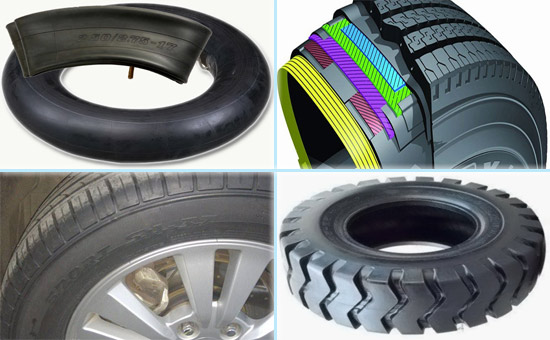
The tires mainly include inner tubes, tires, and current tubeless tires of various types. The butyl reclaimed rubber has excellent airtightness and watertightness. It is usually used in the production of inner tubes instead of butyl rubber to reduce the inner tube production cost; but the butyl regenerated rubber itself is not only In addition to excellent airtightness, it also has good properties such as heat resistance, ozone resistance, and chemical resistance, and it can also play other roles in the production of tires. What are the places where tires can be used in butyl rubber?
1. Application of Butyl Recycled Adhesive in Inner Tube
The main raw material of butyl reclaimed rubber is the waste butyl inner tube, which retains the good airtightness of the original rubber. It is the best raw material for the production of butyl inner tubes instead of butyl rubber, and it is also the most common application method of butyl reclaimed rubber. . When butyl inner rubber is produced from butyl reclaimed rubber, the appropriate butyl regenerated rubber product is selected according to the inner tire index and the amount of butyl regenerated rubber is determined. Under normal circumstances, the amount of butyl reclaimed rubber used in truck tires, inner tubes of passenger cars, and inner tubes of passenger cars is small, and the amount of butyl reclaimed rubber used in inner tubes of motorcycle inner tubes, bicycle inner tubes, etc. It is much lower than butyl rubber. Substituting butyl rubber for the production of butyl inner tubes can significantly reduce raw material costs.
2. Application of Butyl Recycled Rubber in Innerliner of Tire
The tubeless tire is a new type of tire product that has no inner tube and cushion, and utilizes the airtightness of the inner wall of the tire and the bead to ensure the airtightness between the tire and the wheel rim, and is currently more and more widely used. One of the main raw materials of tubeless tires is halogenated butyl rubber, but due to its scarce resources and high cost, it can be replaced with butyl reclaimed rubber. The composition and quality of butyl regenerated rubber are relatively stable, and when used in combination with natural rubber to produce tubeless tire innerliners, it can reduce the cost of raw materials, and can also reduce the amount of fillers and filler oils, significantly improving the airtightness of the innerliner of tires. , To ensure the good performance of tubeless tires. In practical production, when butyl reclaimed rubber is used together with natural rubber to produce tubeless tire innerliner, the amount of butyl regenerated rubber should be controlled at 30-40 parts, and the raw materials should be significantly reduced under the premise of guaranteeing the airtightness of the tire. cost.
3, Butyl reclaimed rubber in the tire sidewall application
The tire sidewall refers to the rubber covering the side wall of the tire tread, the shoulder to the bead, and the part needs to bear the effect of flexion and deformation. Therefore, the resistance to flex cracking, aging and puncture resistance of the used rubber is required. Higher, more use of aniline antioxidants, but the maintenance time is limited, so you can replace part of butadiene rubber in tire sidewall rubber with butyl reclaimed rubber, improve the tire side rubber heat aging oxygen aging, fatigue resistance Performance, extend tire life. Under normal circumstances, the amount of butyl regenerated rubber blended is controlled at about 20 parts to ensure the physical and mechanical properties of the tire sidewalls. The amount of butyl regenerated rubber is replaced by butyl rubber according to the following formula: RIIR dosage = amount of BR replaced × 100/ 30.
4, Butyl reclaimed rubber in sponge tire rubber material application
Sponge tires are tires in which the bladder is replaced with a flexible sponge in the inner cavity of the tire. The biggest feature is that it is not afraid of piercing. It can be used in artillery artillery vehicles or construction machinery. Most of the sponge tires on the market are made of natural rubber, but the natural rubber itself has low heat resistance, large deformation and aging, resulting in a very short service life of the sponge tires; the butyl rubber itself retains the original butyl rubber. Excellent ozone resistance, aging resistance, weather resistance, heat resistance, airtightness, etc. It is used to produce rubber products with high scorch safety, stable product dimensions, and good compatibility with natural rubber, so it is used together with natural rubber. Sponge tires can fully exploit the performance advantages of natural rubber and butyl reclaimed rubber, significantly improving the heat aging resistance, high temperature compression permanent deformation, puncture resistance, and cutting resistance of sponge tires, and prolonging the service life of sponge tires.
Compared with butyl rubber, butyl reclaimed rubber has lower price and better fluidity. Substituting part of the original rubber in the production of tires can not only improve the processing technology and performance of tires, but also can significantly reduce the cost of raw materials.
Exclusive original article [commercial authorization] reprint, excerpt and excerpt in any form are prohibited without written authorization. Focus on Hongyun rubber: learn the process formula and raw material technology of producing rubber products from recycled rubber to help you reduce costs and increase profits